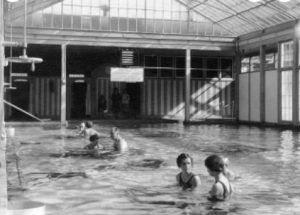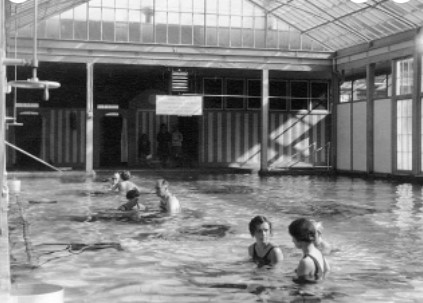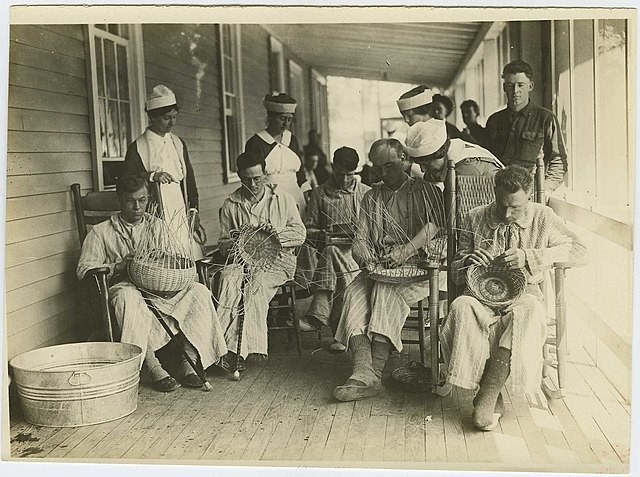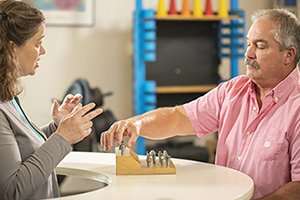
May 12, 2023
Submitted by:
Christopher Schmidt
Kessler Rehabilitation
771 Bloomfield Avenue Broadway Square West Caldwell NJ 07006
(973) 521-5554
cschmidt@kessler-rehab.com
How the ravages of history launched two profound professions
Posted 4/19/2023
When a doctor recommends occupational therapy (OT), rather than physical therapy (PT), many people don't at first realize there are two kinds of therapies.
It might also not be understood that there's a difference between them, or why a doctor prescribes one over the other.
As therapists, we get this question a lot.
For sure, there's a difference between the therapies and how they're used in healing and recovery. And the story is more interesting than you might imagine…
A short history of modern therapy
Movement and manual therapies can be traced back to ancient Asia, Greece and Rome. Those early practices included massage and hydrotherapy (water therapy).

In the 1920s and ‘30s, Franklin D. Roosevelt found relief with hydrotherapy. FDR receiving physical therapy or exercising with assistance in an indoor pool at Warm Springs, GA, 1928. Courtesy of Franklin D. Roosevelt Presidential Library and Museum.
Fast-forward to modern-day therapy which began in 18th century Sweden with the practice of orthopedics — the medical focus on bones and muscles.
A bit later, Hanrik Ling, developed the Swedish Gymnastic System (also known as the Swedish Movement Cure). His motivation? Having experienced the benefit of improved body movement through his practice of fencing.
At its core, Ling's system emphasized physical conditioning for its ability to improve health and body function. It combined lesser intensive floor-style of gymnastics with manual therapy. Ling's approach brought wide acceptance of his methods.
In 1813, the Swedish government appointed Ling to start the Royal Central Institute of Gymnastics (RCIG).
Ling's system became wider spread as graduates of the RCIG adopted its four core components:
- physical education
- fencing
- massage, physical therapy, physiotherapy
- dance performance
One more fast-forward to the 1920s. The polio epidemic was raging in the United States, especially among children.
During the epidemic, two schools of thought emerged.
One used the practice of immobilizing the limbs of patients believing limb movement and stretching would impair muscle recovery and cause more deformity.
A second practice re-introduced the Roman practice of hydrotherapy. Here therapists used exercise in heated pools to improve a patient's muscle recovery and movement.
Polio paralysis spurred working with patients to improve balance and regain muscle strength. The benefit of warm water was helpful as well as buoyancy – water supports body weight and reduces stress on the joints.
The practice – active polio therapy – helped grow a population of physical therapy (PT) specialists who became instrumental in treating polio paralysis.
These early PTs developed methods for assessing and strengthening muscles – methods still used today.
This piece of history gave the push to establishing the profession of physical therapy in the U.S.
Turning now to the topic of occupational therapy (OT), its history doesn't stretch back as far as those of physical therapy.
But its roots in America began to grown in the late 1800s. This happened primarily as a way to help individuals with mental illness by engaging them in meaningful tasks. Examples include gardening, painting and arts and crafts creation.
The U.S. military also began recognizing the importance of mental health services for wounded and traumatized soldiers to help them resume daily living.
This marked an entry for OT services in the treatment of individuals with mental and physical needs.
Three movements of thought were significant in the development of OT:
- The consensus that mental health patients should be treated and not put in asylums or prisons.
- The reemergence of the value of manual occupation and vocational skills over mass production.
- The rise of thought that working with your hands to produce items of value can be beneficial to a person’s overall health.
During this time, mental health asylums changed to reflect these new ideas. They were ideas of humane rehabilitation and included craft and recreational activities to help patients return to society through their contributions.
These ideas were foundational for developing OT.
About 1915, a social worker named Eleanor Clark Slagle started the first formal OT education program at John Hopkins University in Baltimore.
Dubbed the "mother of occupational therapy" she trained more than 4,000 therapists and promoted OT within the medical community.
While PT and OT therapies were in their infancy on the two sides of the Atlantic, it was America's entry into the Great War in 1917 where they came together.
To summarize some of the above timeframes, it's worth a look at how it happened.
World War I and its transformation of therapy
World War I transformed medicine and contributed to the development of today's scope of medical care.
The total number of military and civilian casualties in World War I was about 40 million.. and about 23 million wounded military personnel.
– Wikipedia
With the staggering number of wounded worldwide, orthopedics and therapists rapidly advanced to meet the need.
The course of thought was that society had a moral responsibility to help these soldiers return to a normal and purposeful life. Thus, medical specialties developed to fill this need.
The U.S. military hired a small group of women, calling them "reconstruction aides." In their roles they provided treatment by teaching occupation skills to the wounded.
The initial 18 aides were trained in the latest European physiotherapy practices at the time. Aides were chosen from civilian women and women from the newly established profession of OT.
Both therapy groups expanded rapidly to help the soldiers with recovery.
Of the original 18 Aides, 16 went on to form the American Women's Physical Therapeutic Association. This later became the American Physical Therapy Association with McMillan as president.
– The U.S. World War One Centennial Commission.

Soldiers recovering from severe wounds learn basket weaving as a form of occupational therapy, led by the World War Reconstruction Aides Assocation. Learning basket weaving (Reeve 000290), National Museum of Health and Medicine.
The work of these aides brought the military to begin seeing disability in terms of capability in function, and not as limitation.
Their successes were many, helping wounded soldiers learn to walk again and freely move about in their environments.
These early therapists gave training in the use of arm prosthetics, adapted home and work spaces and taught crafts and vocational skills for mental diversion and future employment.
The convergence of today's therapies and practitioners
After WWI, occupational and physical therapy continued to advance.
And with their evolutions came recognition for the benefits they each provided.
But sometimes there was division in which to prescribe: occupational therapy vs physical therapy.
What became clear over time, with advances in the professions, is the benefit to individuals when providing therapies in tandem.
Today's occupational and physical therapists work together in the shared goal of improving an individual’s function through movement.
As individual medical treatments, the therapies, when used together, can have profound results.
Because of this they are recognized as separate but symbiotic professions.
Similarities include:
Working in a variety of settings
- Schools
- Outpatient rehabilitation centers
- Home health agencies
- Hospitals
- Nursing homes
Training in key disciplines
- Science
- Anatomy
- Kinesiology
Using similar therapy techniques
- Soft tissue mobilization
- Functional activities
- Strengthening
- Stretching
- Pain relief
Opposites attract, even in medicine
Even with similarities between the two professions, there are also key differences.
Physical therapy focuses on improving movement, flexibility and mobility. This includes improving physical motion required for a task.
Physical therapy has a unique approach to mobility – movement and muscle balance. It uses prescribed treatment techniques to maximize function, capacity and performance.
PTs work with patients before and after surgery to build strength and kick-start healing. Therapy uses movement to reduce pain, recover from an injury and promote balance to reduce the risk of falls.
The occupational therapy profession has a different focus.
That focus is on functional ability – the ability of an individual to do activities, work and tasks that are normally performed in everyday living and occupation.

That focus gives occupational therapy its name.
Occupation is defined as an activity that is meaningful and purposeful to the individual. It can include basic activities such as dressing, bathing or fixing a meal.
It can also include specific activities which are unique to the individual.
For example, you may be a high school teacher, home gardener, pianist or an electrician. Each occupation requires a unique set of activities. If those activities are compromised by illness or injury, OTs can help.
Your therapist will assess your current function and how to improve your ability to perform a task or modify it to help you complete it.
Now that you know more about the differences between OT and PT, should you need therapy you'll be able to spot the differences in what your therapist recommends.
Of course, it all depends on your condition, your needs, and personal goals.
But thanks to a long history of the disciplines, and more than a century of experience since WWI, PTs and OTs are specialists in your care.
Our job is to help get you back to enjoying the activities that matter to you.
If you or someone in your family might benefit from our therapies, request an appointment with us. We're here to help.
